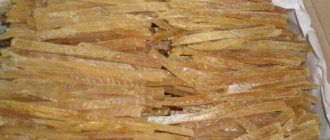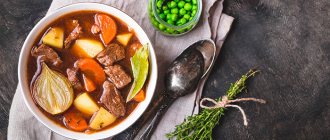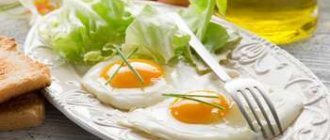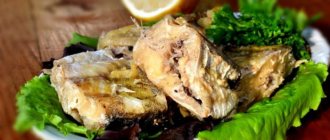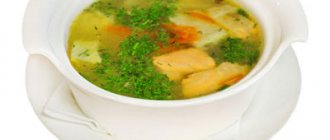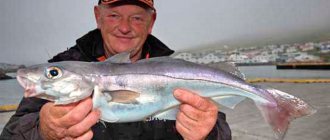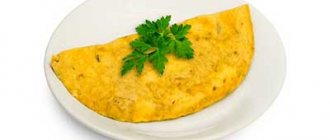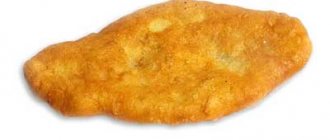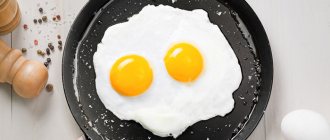01/09/2015 / Fish and seafood
| Fried carp, BZHU and calorie content per 100 g of product | |||
| Calorie content 196 kcal | Proteins 18.3 g | Fat 11.6 g | Carbohydrates 4.6 g |
One of the most popular types of fish is carp. Once upon a time, a long time ago, the Chinese managed to tame wild carp and turn it into an excellent domestic fish. This is how the carp turned out.
Carp grow very quickly and can reach a length of more than a meter. Facts indicate that there are individuals up to 20 kg in weight and quite advanced in age. Carp has dark, large scales. Due to its ability to quickly reproduce and gain weight, carp has become an exclusively commercial product. Fishing companies specially create artificial reservoirs for breeding this species.
How many calories are in different types of fried fish?
The energy value of this dish is primarily determined by how many calories are in the key raw product. Thus, pollock and cod are among the most dietary types of fish, and after heat treatment they will still be lighter than a fried salmon steak. Red sea fish are usually a little fattier and therefore higher in calories than white river fish. For this reason, they are often recommended to be steamed or baked to avoid adding “weight”.
Also, to decide the question of how many calories are in fried fish, it is worth considering the specific recipe. Basically, the product is prepared in oil, which is absorbed very well, especially into soft fillets of pollock, pangasius, and haddock. How many calories the fish will gain depends on the volume and type of oil. Creamy is a little lighter - 771 kcal per 100 g, but vegetable has more than 800 kcal, so you should be careful with it.
If you want dietary fried fish, cook it in a dry grill pan or only lightly grease the bottom with oil: do not let the product float in fat.
Various additives also significantly add calories to fried fish: breading in flour or breadcrumbs is even more so than egg-milk batter. And if you sprinkle the product with cheese when frying, not only the number of calories will increase, but also the volume of fat. Approximate calorie values for different types of fish fried without additives in vegetable oil:
- Pollock – 137 kcal.
- Crucian carp – 121 kcal.
- Carp – 197 kcal.
- Pike – 127 kcal.
- Flounder – 91 kcal.
- Cod – 60 kcal.
The approximate calorie content of fried fish without additives ranges from 60-200 kcal , depending on the type of product. If you prepare the product by rolling it in flour, the indicator will increase by 30-50 kcal: the figure is determined by the amount of breading.
How to calculate the calorie content of fried fish?
Turning to open sources for ready-made data every time is difficult. Moreover, no one will give you the exact values: they depend on your recipe. In order to roughly understand how many calories are in fish fried in flour, batter, cheese and other additives, you should remember the principles of counting:
- The vegetable or butter that you use for frying is not completely absorbed into the fish, and part of it also burns out - those areas where the fish pieces do not lie. Therefore, experts advise adding approximately 50% of the oil used to the calorie content of the fish.
- The calorie content of the fish itself is calculated based on the raw product. If you fry a 100 g piece, and during heat treatment it decreases in weight to 80 g, its calorie content still remains the same as 100 g.
- For complex dishes, the calorie content of each product is added together and the resulting number is divided by the total weight of the components and multiplied by 100 to obtain the energy value for a 100-gram serving.
Fried carp
Fried carp is an incredibly tasty, but fantastically easy to prepare dish. We buy or catch large fish ourselves (1.5-2 kg), clean, wash, bread and fry in vegetable oil. On the way out, we feast on amazing gourmet food. The calorie content will be high, but the pleasure from what you eat will be no less. Once a month you can arrange a loading fish day.
There are many delicious ways of frying: baking in the oven, on the grill, in a frying pan. The last option is the most popular and unpretentious.
Calorie content of fresh carp
Carp is a freshwater fish that was artificially raised in China and successfully migrated to the waters of Russia and Europe.
It owes its popularity to its rapid growth and active reproduction. Carp is quite hardy, largely thanks to this it became a symbol of samurai strength for the Japanese. In Feng Shui, carp is a sacred fish that signifies success and abundance. In the modern world, it is a wonderful combination of useful chemical compounds and sweetish, tender meat. Useful minerals: manganese, phosphorus, cobalt, nickel, chromium, magnesium, iron, molybdenum, potassium, fluorine, sodium, etc.
Calorie content of boiled carp
Carp is a fish that was bred artificially.
Several centuries ago in China they were able to domesticate carp and called this fish carp, after which this fish began to be successfully bred in Russia and Europe. There are several types of carp, among them there is a genetically created mirror carp, which has no scales. In the Czech Republic, a dish of mirror carp is traditionally served on the Christmas table. The meat of this fish contains many components that improve human health. Useful minerals: chlorine, iodine, nickel, calcium, manganese, cobalt, phosphorus, magnesium, chromium, molybdenum, potassium, fluorine, sodium. Vitamins: A, B1, B5, B9, B12, E, C, PP.
There is a misconception that carp is a rather fatty and high-calorie fish, which is clearly not true. Boiled carp can perfectly complement a restorative diet. It is boiled both in water and in beer, which gives the meat a piquant taste. Boiled carp meat will be welcome in every kitchen, because it goes well with various types of cereals, potatoes and vegetables.
Calorie content of boiled carp is 102 kcal. It also contains proteins - 16.0 g, carbohydrates - 2.0 g, fats - 3.7.
A balanced content of vitamins and chemical elements that strengthen joints and bones can reduce the likelihood of developing arthritis or osteoporosis in old age. The increased zinc content allows the child’s body to develop more actively and prevent complications during its growth.
Application
Carp is used in a variety of interpretations and conditions. Fried carp is extremely tasty. Its meat is soft and tender, with some sweetish undertones. Small bones are practically absent. Carp is fried in a large amount of sunflower oil and served with spices. Fried cap is an excellent appetizer and enjoys undeniable authority in the best restaurants in the world.
There are no contraindications for eating carp, although people with stomach or digestive problems should not overuse this fried product.
You should be careful when choosing fish. The mucus on the scales should not stick to your fingers, but be slippery. There should be no traces of blood on the body of the fish - this indicates that the carp was unhealthy. A small one-year-old carp is best suited for cooking, including frying. It is during this period that carp has the most delicious meat.
Market Analytics
- Global cosmetics market 2021: an unprecedented test for the global cosmetics industry
- Top 10 Cosmetic Research and Development of 2021
- 2020 in the beauty industry – innovation without borders
Convenient search for beauty salons on our website
Beauty salons in Moscow Beauty salons in St. Petersburg Beauty salons in Ekaterinburg Beauty salons in Novosibirsk
Latest blog posts on our website
- Naturecream / Properties of the “Sunny” oil itself
- Naturecream / “Sugar” wrinkles - or what glycation can do
- Naturecream / Esterified oils
- Naturecream / Arnica - the magical plant of alchemists
- Naturecream / Tremella Extract - Snow Mushroom Detox for Skin
- Prostye-sovety / How to visually enlarge your lips with makeup
- Naturecream / Apricot kernel oil for face
- Naturecream / MATRIXYL3000 - the best skin elasticity stimulator
- Naturecream / SPF in Natural Oils
- Naturecream / Geranium (Pelargonium) oil for skin health and beauty
Latest forum topics on our website
- Natalya / How to properly make a gelatin mask?
- Mrs._Smith / Badly sunburned! What to do?((
- Ice / Is it necessary to combine fitness classes with a diet?
- Antonova / What can be used for hair loss?
- Radio operatorKat / Who was on a protein diet?
Other articles in this section
| Crab sausage Quite recently, crab sausage has appeared on store shelves. This product is completely new to people and not many people even know what it is. But many people liked the crab sausage. The goods began to sell out very quickly. This product is made from surimi. Crab sticks and meat are also prepared from it. |
| Boiled hake Hake is one of the representatives of cod species and belongs to the hake genus. This is a sea fish with healthy and tasty meat. Its habitat is the Pacific and Atlantic oceans. A medium-sized individual weighs about 3 kg and reaches a length of up to 40 cm. Its body is elongated and silver in color. |
| Steamed salmon Steaming food in modern Russia has gained popularity relatively recently. But, despite its youth, many housewives fell in love with this method of cooking. Many people especially like steamed salmon. After all, this is quite a satisfying and nutritious food, because this fish is quite fatty. And if the first two of its properties are often welcomed, then, you must admit, not everyone is ready to eat fatty fish. And the best way to get rid of this fat is to steam it. |
| Shark fins The shark is a large elasmobranch cartilaginous fish and is one of the oldest representatives of the inhabitants of sea waters. Most species, of which there are more than four hundred in total, have a large elongated body, several jaws, each of which is covered with a huge number of sharp teeth, and also has a large caudal fin. |
| Poached sturgeon Sturgeon is a valuable species of fish that belongs to the sturgeon family. They live in bodies of water located in the northern hemisphere of the Earth. Many species of sturgeon are common in both Eurasia and North America. Sturgeons have no scales, and characteristic bony plates are located on the skin of the body. Most often, sturgeon reach the following sizes: from 1.5 to 2 meters in length and weighing up to 85 kg. But there are individuals of completely unique sizes, about 4 meters long and weighing 200 kg. |
| Pike in tomato sauce Pike is a predatory fish. She has a very large mouth containing many teeth. The teeth of this fish resemble hooks, and if the victim gets into the pike’s mouth, it will no longer be possible to escape from the mouth. |
| Fried squid A dish of fried squid is common in countries on the Mediterranean coast. The process of preparing this dish is quite simple, just cut the pre-cleaned squid into rings, roll in wheat or chickpea flour and fry in a frying pan with the addition of vegetable and olive oil. |
| Boiled trout The feast of the Russian nobility has always been famous for its abundance and luxury. And trout occupied a special place in the dishes. An amazing feature of this fish is that it can live in fresh and salt water. But the most delicious fish is considered to be the one caught from clean lakes and mountain streams. |
| Pickled herring Herring is a very tasty, nutritious, but at the same time delicate food, it has excellent dietary properties, is rich in valuable biological elements, is easily absorbed by the human body and, finally, gives a wide scope for culinary imagination. |
| Sea urchin caviar Sea urchins are very interesting animals belonging to the class of echinoderms. Most species have a round body shape. Their shell is studded with a huge number of spines, which not only help the hedgehog move, but also perform a protective function. Sea urchins live mainly in the waters of the Pacific Ocean. |
Calorie content of fried carp
Carp is a domesticated carp.
Literally, “carp” translates as “fruit, harvest.” This type of fish was initially bred in China, where it managed to gain wide popularity and after some time spread throughout Russia, Europe and even Japan. As for China, carp dishes were served on the imperial table. Universal love for carp came not only for its fertility and rapid growth, but also for a whole range of useful components. Useful minerals: zinc, iron, calcium, nickel, sulfur, iodine, molybdenum, magnesium, chlorine, sulfur, sodium, cobalt, copper, phosphorus, chromium, potassium, fluorine, manganese. Vitamins: A, B1, B5, B9, B12, E, C, PP.
Fried carp 0 is one of the most common options for preparing this wonderful fish. Carp is fried with plenty of spices and sunflower oil. The meat of the carp is juicy and tender, with a slight sweetish aftertaste.
Calorie content of fried carp – 196 kcal. The composition also contained proteins - 18.3 g, carbohydrates - 4.5 g, fats - 11.6 g.
The advantages of carp include its beneficial effect on the general condition of the skin, nails, and hair. It is also able to reduce the amount of sugar in the blood and participate in the normalization of the functioning of the digestive and nervous systems.
When buying carp, as when choosing other fish, you need to pay attention to the abdomen and gills. The mucus on the scales should not stick to the fingers, which indicates the inappropriate quality of the fish, but should slide. Also, the carp can be felt from different sides; it must be elastic. If you find blood on the fish, then most likely the fish is sick.
Nutritional value of the dish
Fish is one of the main products that should always be in our diet. And all thanks to the composition. Carp is not only a source of phosphorus and iodine, but also such vitamins (A, representatives of group B, vitamins E, PP), various mineral components: nickel, manganese, cobalt, sodium, chlorine, fluorine, molybdenum, etc.
As for the balance of BJU, these indicators depend on the products used in the cooking process. Below we offer the values of some carp dishes (per 100 grams of product):
- Fresh carp – 16.0/5.3/0.0 g
- Mirror – 16.00/5.3/0.33 g
- Baked with mustard and mayonnaise – 15.51/6.8/0.45 g
- Carp soup – 4.5/2.4/1.0 g
- With vegetables in a slow cooker – 8.4/5.8/4.2 g
- Baked with sour cream and onions – 11.3/5.0/2.8 g
- Canned – 13.6/8.7/1.4 g
- Nutritional value of baked with vegetables – 11.0/7.1/3.7 g
- Marinated – 13.6/8.7/1.4 g
- Fried fish (in a frying pan) – 18.3/11.6/4.5 g
- Baked with mustard – 13.9/7.2/0.9 g
- Fish cabbage soup – 2.7/1.9/1.6 g
- Fried with onions – 12.89/5.64/3.49 g
- Steam – 15.81/5.24/0.04 g
- According to the Korean recipe – 15.1/5.37/02.72 g
- Fish with garlic sauce – 12.9/13.96/0.7 g
- Boiled – 16.0/3.7/2.0 g
- Fish soup with tomatoes – 2.8/1.3/1.6 g
- Caviar – 28.00/10.00/0.00 g
- Smoked fish – 16.0/5.3/0.0 g
- Dried version – 17.70/1.80/0.0 g
- Fried in flour – 22.00/14.00/0.0 g
- Cooked in foil in the oven – 11.98/6.83/3.36 g
Fried fish - calorie content, composition, cooking methods
Everyone knows that fish has many beneficial properties for the human body.
Have you ever thought about how many calories are in fried river fish? After all, this dish is perhaps one of the most common fish dishes in home cooking in central Russia. Fish is well suited for those who monitor their diet for the sake of health, strive to be slim, and eat strictly according to calculated calories. This product contains a large amount of vitamins and minerals necessary for maintaining health and long life. How many calories there will be in a dish depends on the type of fish and how it is processed. For example, if you fry, the food is soaked in vegetable oil, so the calorie content of such a dish will be higher than that of a similar steamed one.
Calorie content of carp
Fish itself is low in calories, but during the preparation of various dishes the indicators increase significantly. Therefore, you should be careful about your diet during dieting.
Below are data for some recipes (per 100 grams of finished product):
- Fresh fish – 112 kcal.
- Mirror - 110.33 kcal.
- Baked with mayonnaise – 125.16.
- The nutritional value of fish soup (the calorie content of the head and spine is not taken into account in the calculations) is 44.1 units.
- With vegetables, boiled in a slow cooker without oil – 101.0.
- Baked with onions and sour cream – 100.6 kcal.
- Canned – 138.0 kcal.
- Baked in the oven with vegetables – 122.0 kcal.
- Pickled – 138 units.
- Fried in a frying pan – 196 kcal.
- Baked with 30 percent sour cream and mustard – 124.3.
- Cabbage soup with carp, sauerkraut and mushrooms – 33.3 kcal.
- The nutritional value of fried with onions is 115.26.
- Steamed – 110.81 units.
- In Korean – 111.61.
- In garlic sauce – 179.9 kcal.
- Boiled calorie content – 102.
- The indicators for fish soup with tomatoes are 28.8 units.
- Caviar – 200.0 kcal.
- Smoked – 112.0.
- Dried – 87.0 kcal.
- Fried in flour – 236.0 units.
- Baked in foil – 122.50 kcal.
Give preference to dietary options for preparing carp and feel free to include this fish in your diet.
Fish dishes and diets
According to many people, high-fat varieties are too high in calories, so they refuse to consume them, preferring strict diets, unaware of the beneficial effects of fish dishes on health.
The amount of protein and calories contained in fish depends on its type. River fish has much fewer calories than sea fish. The product contains Omega polyunsaturated acids, which burn fat and accelerate blood circulation by reducing lipids. Even for obese people, the calorie content of the richest type of fat is considered negligible.
All fish, regardless of type, have nutritional value and are high in potassium, phosphorus and magnesium. A good example, a close relative of cod, the river burbot, has a liver rich in vitamins B, A, E, D.
This is a product that has high nutritional value and low calorie content, which allows you to live a long time without disease. A fish diet restores blood pressure, prevents the development of atherosclerosis, and lowers cholesterol. It doesn’t matter how many calories there are in fish when you know about its nutritional value, the amount of vitamins and minerals that are present in it.
If you want to lose 3 to 5 kg of weight, then eat fish dishes for 10 days. It is better to use low-fat fish and fry it in a minimum amount of oil. You can eat green vegetables along with it and you need to drink plenty of water.
Recipe Fish (carp) fried in a frying pan. Calorie, chemical composition and nutritional value.
Nutritional value and chemical composition of “Fish (carp) fried in a frying pan.”
The table shows the nutritional content (calories, proteins, fats, carbohydrates, vitamins and minerals) per 100 grams of edible portion.
| Nutrient | Quantity | Norm** | % of the norm in 100 g | % of the norm in 100 kcal | 100% normal |
| Calorie content | 239.2 kcal | 1684 kcal | 14.2% | 5.9% | 704 g |
| Squirrels | 19 g | 76 g | 25% | 10.5% | 400 g |
| Fats | 17 g | 56 g | 30.4% | 12.7% | 329 g |
| Carbohydrates | 2.5 g | 219 g | 1.1% | 0.5% | 8760 g |
| Alimentary fiber | 0.1 g | 20 g | 0.5% | 0.2% | 20000 g |
| Water | 59.9 g | 2273 g | 2.6% | 1.1% | 3795 g |
| Ash | 1.528 g | ~ | |||
| Vitamins | |||||
| Vitamin A, RE | 23.2 mcg | 900 mcg | 2.6% | 1.1% | 3879 g |
| Retinol | 0.023 mg | ~ | |||
| Vitamin B1, thiamine | 0.169 mg | 1.5 mg | 11.3% | 4.7% | 888 g |
| Vitamin B2, riboflavin | 0.065 mg | 1.8 mg | 3.6% | 1.5% | 2769 g |
| Vitamin B4, choline | 77.39 mg | 500 mg | 15.5% | 6.5% | 646 g |
| Vitamin B5, pantothenic | 0.243 mg | 5 mg | 4.9% | 2% | 2058 g |
| Vitamin B6, pyridoxine | 0.204 mg | 2 mg | 10.2% | 4.3% | 980 g |
| Vitamin B9, folates | 11.78 mcg | 400 mcg | 2.9% | 1.2% | 3396 g |
| Vitamin B12, cobalamin | 1.743 mcg | 3 mcg | 58.1% | 24.3% | 172 g |
| Vitamin C, ascorbic acid | 1.74 mg | 90 mg | 1.9% | 0.8% | 5172 g |
| Vitamin D, calciferol | 28.698 mcg | 10 mcg | 287% | 120% | 35 g |
| Vitamin E, alpha tocopherol, TE | 5.383 mg | 15 mg | 35.9% | 15% | 279 g |
| Vitamin H, biotin | 0.072 mcg | 50 mcg | 0.1% | 69444 g | |
| Vitamin K, phylloquinone | 0.1 mcg | 120 mcg | 0.1% | 120000 g | |
| Vitamin RR, NE | 6.4982 mg | 20 mg | 32.5% | 13.6% | 308 g |
| Niacin | 2.948 mg | ~ | |||
| Macronutrients | |||||
| Potassium, K | 312.28 mg | 2500 mg | 12.5% | 5.2% | 801 g |
| Calcium, Ca | 41.31 mg | 1000 mg | 4.1% | 1.7% | 2421 g |
| Silicon, Si | 0.144 mg | 30 mg | 0.5% | 0.2% | 20833 g |
| Magnesium, Mg | 29.62 mg | 400 mg | 7.4% | 3.1% | 1350 g |
| Sodium, Na | 64.01 mg | 1300 mg | 4.9% | 2% | 2031 |
| Sera, S | 211.65 mg | 1000 mg | 21.2% | 8.9% | 472 g |
| Phosphorus, P | 247.3 mg | 800 mg | 30.9% | 12.9% | 323 g |
| Chlorine, Cl | 64.62 mg | 2300 mg | 2.8% | 1.2% | 3559 g |
| Microelements | |||||
| Aluminium, Al | 37.8 mcg | ~ | |||
| Bor, B | 1.3 mcg | ~ | |||
| Vanadium, V | 3.24 mcg | ~ | |||
| Iron, Fe | 0.973 mg | 18 mg | 5.4% | 2.3% | 1850 g |
| Yod, I | 5.86 mcg | 150 mcg | 3.9% | 1.6% | 2560 g |
| Cobalt, Co | 40.723 mcg | 10 mcg | 407.2% | 170.2% | 25 g |
| Manganese, Mn | 0.1948 mg | 2 mg | 9.7% | 4.1% | 1027 g |
| Copper, Cu | 154.64 mcg | 1000 mcg | 15.5% | 6.5% | 647 g |
| Molybdenum, Mo | 5.097 mcg | 70 mcg | 7.3% | 3.1% | 1373 g |
| Nickel, Ni | 8.212 mcg | ~ | |||
| Tin, Sn | 0.19 mcg | ~ | |||
| Selenium, Se | 14.855 mcg | 55 mcg | 27% | 11.3% | 370 g |
| Titanium, Ti | 0.4 mcg | ~ | |||
| Fluorine, F | 29.84 mcg | 4000 mcg | 0.7% | 0.3% | 13405 g |
| Chromium, Cr | 63.98 mcg | 50 mcg | 128% | 53.5% | 78 g |
| Zinc, Zn | 2.4419 mg | 12 mg | 20.3% | 8.5% | 491 g |
| Digestible carbohydrates | |||||
| Starch and dextrins | 2.442 g | ~ | |||
| Essential amino acids | |||||
| Arginine* | 1.046 g | ~ | |||
| Valin | 1.278 g | ~ | |||
| Histidine* | 0.349 g | ~ | |||
| Isoleucine | 0.929 g | ~ | |||
| Leucine | 2.091 g | ~ | |||
| Lysine | 2.208 g | ~ | |||
| Methionine | 0.581 g | ~ | |||
| Methionine + Cysteine | 0.755 g | ~ | |||
| Threonine | 1.046 g | ~ | |||
| Tryptophan | 0.209 g | ~ | |||
| Phenylalanine | 0.929 g | ~ | |||
| Phenylalanine+Tyrosine | 1.51 g | ~ | |||
| Nonessential amino acids | |||||
| Alanin | 1.162 g | ~ | |||
| Aspartic acid | 1.975 g | ~ | |||
| Glycine | 0.697 g | ~ | |||
| Glutamic acid | 3.137 g | ~ | |||
| Proline | 0.581 g | ~ | |||
| Serin | 0.929 g | ~ | |||
| Tyrosine | 0.581 g | ~ | |||
| Cysteine | 0.174 g | ~ | |||
| Sterols (sterols) | |||||
| Cholesterol | 63.9 mg | max 300 mg | |||
| beta sitosterol | 21.583 mg | ~ | |||
| Saturated fatty acids | |||||
| Saturated fatty acids | 2.6 g | max 18.7 g | |||
| 14:0 Miristinovaya | 0.046 g | ~ | |||
| 16:0 Palmitinaya | 1.575 g | ~ | |||
| 17:0 Margarine | 0.012 g | ~ | |||
| 18:0 Stearic | 0.814 g | ~ | |||
| 20:0 Arakhinovaya | 0.032 g | ~ | |||
| 22:0 Begenovaya | 0.087 g | ~ | |||
| Monounsaturated fatty acids | 5.554 g | min 16.8 g | 33.1% | 13.8% | |
| 16:1 Palmitoleic | 0.442 g | ~ | |||
| 18:1 Oleic (omega-9) | 4.974 g | ~ | |||
| 20:1 Gadoleic (omega-9) | 0.116 g | ~ | |||
| 22:1 Erucic (omega-9) | 0.012 g | ~ | |||
| Polyunsaturated fatty acids | 6.872 g | from 11.2 to 20.6 g | 61.4% | 25.7% | |
| 18:2 Linolevaya | 6.767 g | ~ | |||
| 18:3 Linolenic | 0.035 g | ~ | |||
| 18:4 Steoride Omega-3 | 0.012 g | ~ | |||
| 20:4 Arachidonic | 0.023 g | ~ | |||
| Omega-3 fatty acids | 0.1 g | from 0.9 to 3.7 g | 11.1% | 4.6% | |
| 22:5 Docosapentaenoic acid (DPA), Omega-3 | 0.012 g | ~ | |||
| 22:6 Docosahexaenoic acid (DHA), Omega-3 | 0.023 g | ~ | |||
| Omega-6 fatty acids | 0.3 g | from 4.7 to 16.8 g | 6.4% | 2.7% |
The energy value of fish (carp) fried in a frying pan is 239.2 kcal.
Primary Source: Created in the application by the user. Read more.
** This table shows the average levels of vitamins and minerals for an adult. If you want to know the norms taking into account your gender, age and other factors, then use the “My Healthy Diet” application.
How many calories are in fish?
Two indicators determine the calorie content: the variety and the method of preparation.
100 grams of fried fish can contain from 68 to 300 calories. Fried, for example, has fewer calories than smoked. As a rule, river fish varieties have lower calorie content than sea fish. Low-fat varieties are considered more valuable for the diet, the calories of which will not affect the metabolic processes of obese people. Based on calorie content, they are divided into:
River fish are mainly medium and low fat, so they are best suited for diets.
Species such as carp, bream, and trout are classified as medium-fat varieties. For example, fried carp has 181 kcal per 100 g; fried bream – 160 Kcal; fried trout – 195 Kcal.
Perch, pike, pike perch are classified as low fat. Fried perch has 180 kcal; pike – 127 Kcal; pike perch – 163 Kcal.
Beneficial features
Carp, as a “cultivated” fish, has a number of valuable characteristics that are extremely rare in other fish species. One of them is its wonderful effect on the nervous and digestive systems. Systematic consumption of carp significantly reduces blood sugar levels, which is an invaluable quality for those people who suffer from diabetes.
In addition, carp stimulates high-quality growth of nails and hair, and has a beneficial effect on the skin. It is not for nothing that in ancient China carp was an integral part of the imperial cuisine.
Advantages and disadvantages of fried fish and how best to cook it
If you take a certain variety and cook it in two ways, for example, steamed and fried, then in the first case the calorie content will be lower than in the second.
But if you are struggling with excess weight and you prefer fried fish rather than boiled fish, then don’t look at the calories, regardless of them, such a delicacy helps burn fat and helps you become slimmer. During frying, high heat treatment occurs, which destroys all possible parasites present in river fish, so this is not only a tasty, but also a safe method of cooking. You need to be able to properly cook fish in order to preserve beneficial vitamins and microelements in it. The most useful in terms of the amount of substances will be fresh fish. During heat treatment, beneficial substances disintegrate, so in fried food there will be fewer of them than in boiled food. Fish is a unique product, despite the widespread belief that everything fried is harmful to the body, because it has a lot of calories, 100 grams on average 140 Kcal, and this is due to the vegetable oils used in cooking.
Carp: benefits and harm
What makes seafood different is that it contains a whole bunch of vitamins and microelements. Fish in particular is an irreplaceable product that can ensure the normal functioning of the human body. Regular consumption of fish can help:
- Improving the general condition of the body, thanks to its replenishment with useful vitamins and minerals.
- Possibility of extending life by blocking free radicals with antioxidants.
- Increasing efficiency and productivity, regardless of the nature of the work: mental or physical.
- Reduced blood sugar levels. This means that carp is recommended for consumption by patients with diabetes.
- Improving the functioning of the gastrointestinal tract, while accelerating metabolism.
The main contraindication is excessive consumption of the product. Extra pieces eaten will not do any good. The human body will take as many useful substances as it lacks. In addition, there is also such a thing as a balanced diet. In other words, the diet cannot consist of only one fish, even if it is healthy and contains so many useful components. In any case, it is better to rely on gastronomic preferences.
How to fry river fish
The best varieties for frying are carp, carp, and bream; the dish from them will turn out juicy, regardless of the cooking method.
First you need to clean the fish from scales, usually this is done with a special knife. Next, wash off the remaining scales with running water, gut the fish, cut off the fins, remove the gills or completely cut off the head, and rinse again. If you don’t like to take the bones out of the fish, there is a little trick - make transverse cuts on the back, so the small bones, of which there are a lot in this part, will not be felt after frying, they will steam and become softer. Rub the fish with salt and pepper and wait 30-50 minutes. Roll in flour and place in a preheated frying pan with plenty of vegetable oil; the fish will taste better if it is unrefined. Fry on both sides until golden brown. Delicious fried fish is ready. Bon appetit!

